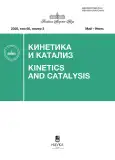Kinetics and Catalysis
Media registration certificate: № 0110218 от 08.02.1993
Founders: Russian Academy of Sciences, Institute of Organic Chemistry of RAS
Editor-in-chief: Bukhtiyarov V.I., academician RAS, Doctor of Sc., Full Professor
Frequency / Access: 6 issues per year / Subscription
Included in: White list (2nd level), Higher Attestation Commission list, RISC
Ағымдағы шығарылым
Том 66, № 3 (2025)
ОБЗОР
Ceria-supported platinum water gas shift catalysts: composition, structure, reaction mechanism
Аннотация
 149-165
149-165


ARTICLES
Study of deactivation of Mg-containing zeolite catalyst in propane conversion into olefinic hydrocarbons
Аннотация
 166-176
166-176


Effect of the nature of alkali metal on the activity of carbon nanofibers in the catalytic decomposition of formic acid
Аннотация
 177-188
177-188


XPS STUDY OF DIFFERENCES IN STABILITY OF MWCNTS AND N-MWCNTS AS A SUPPORT FOR MODEL SILVER CATALYST FOR ETHYLENE EPOXIDATION
Аннотация
 189-203
189-203


Low-temperature O3-catalytic oxidation of VOC’s on a bifunctional Cо–W/Al2O3 catalyst
Аннотация
 204-208
204-208


Effect of migration of nickel of carbon nanofiber support into active phase of molibdenum disulfide based catalyst of alcohol synthesis
Аннотация
 209-224
209-224


Interaction of ethanol with the surface of nickel supported catalysts as determined by in situ IR-spectroscopy
Аннотация
 225-234
225-234


NI-CONTAINING GLASS-FIBER CATALYST FOR HYDROGENOLYSIS OF LIGHT PARAFFINS: RELATIONSHIP BETWEEN ACTIVITY AND CATALYST PREPARATION CONDITIONS
Аннотация
 235-248
235-248












